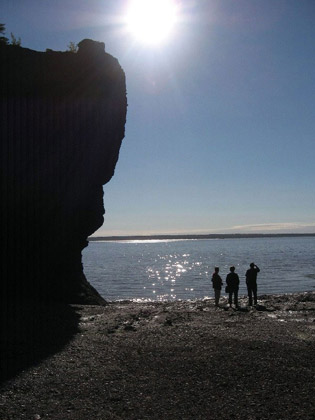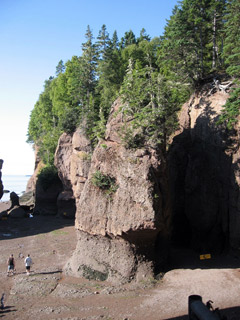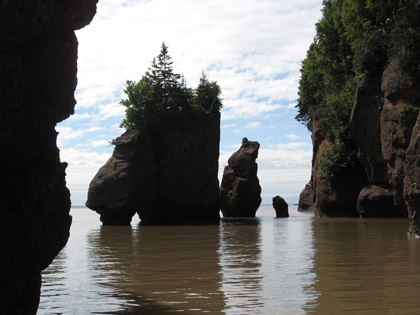Hopewell Rocks -
Beating the rush (and tide) at Hopewell Rocks JOSH HANSEN |
 | |
| The Bay of Fundy's rolling tides rise about an average of |
But as I slip through the scrum and over a patch of beached seaweed, two security guards stop me and usher me in the opposite direction. The tide comes in quickly and the right side of the beach is filling up fast. I reluctantly comply, having missed the chance to see Diamond Rock up close. I snap a photo of it later on anyway, from a nearby observation. By then the water level has risen almost 40 feet - 39.7 in fact – in a little over two hours, giving the busload of Germans and I exactly what we bargained for: high tide at Hopewell Rocks.
Mic Mac legend says the rocks are former runaway slaves who were turned to stone by the Great Whales. Modern day geologists would strongly disagree. The giant pieces of sand and gravel were brought here by Glacier Mountains some 300 million years ago. Once part of the dominating landscape, their unique shapes were carved by the continuous lashings brought on by the Bay of Fundy’s furious tides. Vegetation still remains on top of many of the massive pebbles. The force is so strong that it has carved a hole big enough to drive an ice cream truck through in the center of one rock. When the tide rises, the hole is reduced to the size of a church bell.
Two unique characteristics define why Hopewell Rocks sees the Bay of Fundy’s highest tides. For starters, one must understand the Bay’s funnel shape. At its mouth, the bay measures about 100 km (62 miles) wide and between 400-700 feet deep. The area around Hopewell Rocks is about 2.5 km (1.5 miles) and about 45 feet deep at low tide. The gradual drop off in both depth and size restricts tidal flow, leaving the water with only one direction to go: up. Secondly, it takes a long time to fill the world’s largest bathtub. It takes almost the same amount of time to flood the length of the Bay of Fundy as it does for the adjoining Gulf of Maine.
The combination creates what is called the "Saiche Effect". Essentially, the water moves like a child sloshing water back and forth in the bathtub, each wave being bigger than the last. The intense erosions make the immense boulders as dangerous as they beautiful. The tide removes about two feet of rock each year from the area. In 2002, a rock formation weighing 50 tonnes broke off from the cliff. The rock landed in an area about 700 metres away from the main staircase that was already cordoned off. These areas are marked off with waist-high chains and yellow sign warning visitors of the potential for falling debris. A scaling company inspects the rocks every year. About half a dozen areas are chained off today.
 | |
| A view of low tide at at Hopewell Rocks |
Remarkably, no injuries from fallen rocks have been reported at Hopewell Rocks since the province of New Brunswick acquired it in 1958. In March, the province announced the Department of Tourism and Parks would run the site for the 2007 season, ending a nine year run by American-based Serco FM Inc., whose contract ended on New Year’s Eve, 2006.
Now your best experience at Hopewell Rocks depends as much on the weather as the lunar cycle. A full moon or new moon may produce higher tides compared to a quarter moon and so forth. The reason is gravity. The gravitational pull is stronger on the earth’s water when it is aligned with the moon, and to a lesser extent, the sun. Lower tides are the result of the three masses not being at different points in their rotations. To get an idea of what tides to expect, check the tide tables at least a day in advance and arrive at least three hours before high tide.
I never really understood why people would wait around three hours just to see this happen. Waiting for the water to rise at a rate of one foot every five to ten minutes – my experience equalled one foot about every six and a half minutes – sounds less exciting than watching paint dry. And honestly, it is. Eventually, officials recognized the need to address this problem of what tourists should do while the tide rises. In 1998, the Atlantic Canada Opportunities Agency (ACOA) gave $347,156 for redevelopment of the lower site. Additional ticket kiosks and parking spaces were added, along with a number of landscaping projects.
Most people, like me, walk the trails while waiting for high tide. There are walkways that lead to other observation decks of the rugged cliffs and nearby countryside. Others lead to the cafeteria. I head down a steep, dirt path behind the cafeteria and end up on the beach. There, I meet up with an interpreter who is speaking to a middle-aged couple. He says the beach is the prime vantage point for the annual shorebird feeding. Hundreds of thousands of shorebirds migrate to the beaches between mid-July and early August every year to feast before they migrate to the Artic. The birds double their weight, then leave. About a thousand still remain around the area. Gobbling up every last clam, shrimp and muscle they can.
 | |
| High Tide at Hopewell Rocks takes about only six hours to complete. |
Three hours have passed when I make my way down the stairs that link the observation deck with the smelly mud flats below. But the strong, sulphur scent of mud and ocean is gone. The entire shoreline is gone, submersed by the Bay of Fundy’s tides. The curious, me being one of them, gather at the bottom five steps, within inches of the water. A chain is the only thing that stops the paparazzi from falling in. Chains that used to mark off the dangerous areas on the beach now peak slightly from beneath the water’s crest. Most are under water. Rocks that seemed so dominant just hours before, no longer intimidate me. Somehow, the tide has put me on equal footing, or almost, with these giants. Even though I know that’s the furthest from the truth, the whole place feels completely different.
In another three hours, the ocean will have retreated and another busload of tourists will discover the caves, Mother-In-Law Rock, and maybe even see a shorebird. Then, they’ll be ushered off the beach by security guards, continuing the cycle of the Hopewell Rocks phenomenon.
Home | Add/Modify Listing | Photo Gallery | Maps | Contact | About Us | USA Privacy Statement
This site is operated by 2025 Cedar Lake Software
LastModified: Apr-13-10
